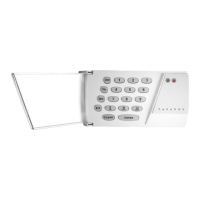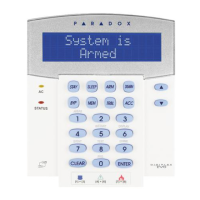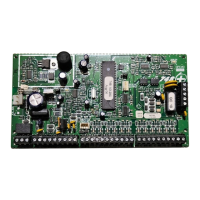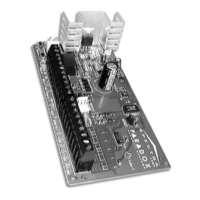Do you have a question about the Paradox Esprit 748 + and is the answer not in the manual?
Explains the manual's content, terminology, and layout conventions.
Highlights key system capabilities like lightning protection and dialer circuit.
Details technical parameters such as battery charger, AC input, and outputs.
Lists available keypads and other security system accessories.
Company philosophy on innovation, user-friendliness, and product development.
Provides instructions for selecting an installation site and mounting the panel.
Details the proper connection to earth ground for safety and lightning protection.
Covers AC power requirements, back-up battery connection, and testing.
Instructions for connecting the incoming telephone line to the control panel.
Guidance on connecting bells and sirens to the panel's output terminals.
Explains how to utilize programmable outputs for various system functions.
Provides wiring instructions for connecting keypads and keyswitches.
Details on connecting detectors or door contacts directly to keypads.
Various methods for connecting single zone input terminals with EOL resistors.
Setup for ATZ feature allowing two detection devices per zone input.
Instructions for connecting smoke detectors to the fire circuit.
Information on connecting additional devices via the serial output connector.
Details on setting and using the installer code for system programming.
Information on programming and using master and user access codes.
Allows selection between 4-digit or 6-digit access codes.
Enables silent alarm dispatch when a specific user code is entered.
Locks programming settings to prevent unauthorized changes.
Utilizing Espload software for remote or local panel programming.
Covers Hexa, Hexa Streamlined, Decimal, Feature Select, and Key Access programming.
Defines how the panel answers incoming calls from Espload software.
Sets a 4-digit code to identify the panel to the Espload software.
Sets a 4-digit password for PC identification to the panel.
Programs the telephone number for initiating PC communication.
Procedure to make the panel call the Espload software.
Manually forces the panel to answer incoming Espload calls.
Cancels active communication and erases unreported events.
Panel calls back the PC to re-verify identification codes.
Automatically transmits event data when buffer reaches 50% capacity.
Defines reporting methods: Regular, Split, and Double reporting.
Programs the primary telephone number for central station reporting.
Programs the secondary telephone number for central station reporting.
Identifies the system or partition to the central station.
Selects the communication format (e.g., Ademco, Radionics) for reporting.
Defines 2-digit hexadecimal codes for various system events.
Schedules automatic system test reports to the central station.
Initiates a manual test report to the central station.
Delays the transmission of power failure event codes.
Sets a delay for reporting recent close events after arming.
Configures when zone restore codes are transmitted after an alarm.
Controls disarming code transmission based on alarm status.
Sets the delay before a zone responds to an open condition.
Enables two detection devices per zone input for increased capacity.
Sets the delay for Intellizones before triggering an alarm.
Zones requiring multiple events within a time frame to trigger an alarm.
Zones that report alarms silently without triggering local bells/sirens.
Zones that are always active, generating alarms regardless of system status.
Zones that trigger an immediate alarm upon opening.
Zones that trigger alarms after entry delay or other zones.
Provides a delay for users to disarm the system after entry.
Provides a second, different delay for user entry.
Divides the system into two distinct, independently controlled systems.
Zones that can be manually bypassed by users for specific operations.
Automatically bypasses zones after multiple consecutive alarms.
Enables or disables the use of End-Of-Line resistors for zone inputs.
Verifies the presence and operation of keypad zone 1.
Verifies the presence and operation of keypad zone 2.
Automatically arms the system at a specified time daily.
Arms the system if no zone openings are detected for a specified period.
Allows arming via single key press for regular or stay/System A modes.
Utilizes a keyswitch for stay or regular arming and disarming.
Enables audible squawks upon arming and disarming the system.
Sets the time allowed for users to leave the protected area.
Provides intermittent beeps during the exit delay period.
Sets a delay before reporting an alarm to the central station.
Configures silent zones/panics to transmit reports only.
Sets the duration the bell or siren sounds after an alarm.
Defines user access levels for arming, disarming, and bypassing.
Defines PGM state, timing, and logic for various outputs.
Sets the duration for timed programmable outputs.
Lists commonly used PGM options and their programming data.
Verifies the presence and integrity of the telephone line connection.
Selects between pulse or tone/DTMF dialing formats.
Sets the pulse ratio for dialing (Europe 1:2 or USA 1:1.5).
Enables panic alarms triggered by specific key combinations.
Sets the current time on the control panel.
Adjusts the panel's clock for gain or loss to maintain accuracy.
Configures detection and reporting of tamper and wire faults.
Prevents alarms from tampered bypassed zones while system is armed.
Enables a mode for performing system walk tests with audible feedback.
Hides power failure issues from the trouble display.
Enables intermittent beeps for system trouble conditions.
Resets the panel to factory defaults by cycling power.
Guides on programming master and user access codes.
Standard method to arm all zones in the system.
Allows regular arming via single key press.
Rapid arming without waiting for the ready indicator.
Partially arms the system, allowing users to remain inside.
Allows stay arming via single key press.
Switches entry delay zones to instant during stay arming.
Allows exiting while the system is stay-armed.
How to arm and disarm partitioned systems (A and B).
Steps for disarming the system after entering.
Stores and displays zones that triggered an alarm.
Using keyswitches or pushbuttons for arming/disarming.
Temporarily disables zones from monitoring for specific tasks.
Restores previously saved zone bypass settings.
Configures zones to chime upon opening for user notification.
Monitors and displays system trouble conditions on the keypad.
Quick programming of features using installer, master, or user 1 codes.
Explains the manual's content, terminology, and layout conventions.
Highlights key system capabilities like lightning protection and dialer circuit.
Details technical parameters such as battery charger, AC input, and outputs.
Lists available keypads and other security system accessories.
Company philosophy on innovation, user-friendliness, and product development.
Provides instructions for selecting an installation site and mounting the panel.
Details the proper connection to earth ground for safety and lightning protection.
Covers AC power requirements, back-up battery connection, and testing.
Instructions for connecting the incoming telephone line to the control panel.
Guidance on connecting bells and sirens to the panel's output terminals.
Explains how to utilize programmable outputs for various system functions.
Provides wiring instructions for connecting keypads and keyswitches.
Details on connecting detectors or door contacts directly to keypads.
Various methods for connecting single zone input terminals with EOL resistors.
Setup for ATZ feature allowing two detection devices per zone input.
Instructions for connecting smoke detectors to the fire circuit.
Information on connecting additional devices via the serial output connector.
Details on setting and using the installer code for system programming.
Information on programming and using master and user access codes.
Allows selection between 4-digit or 6-digit access codes.
Enables silent alarm dispatch when a specific user code is entered.
Locks programming settings to prevent unauthorized changes.
Utilizing Espload software for remote or local panel programming.
Covers Hexa, Hexa Streamlined, Decimal, Feature Select, and Key Access programming.
Defines how the panel answers incoming calls from Espload software.
Sets a 4-digit code to identify the panel to the Espload software.
Sets a 4-digit password for PC identification to the panel.
Programs the telephone number for initiating PC communication.
Procedure to make the panel call the Espload software.
Manually forces the panel to answer incoming Espload calls.
Cancels active communication and erases unreported events.
Panel calls back the PC to re-verify identification codes.
Automatically transmits event data when buffer reaches 50% capacity.
Defines reporting methods: Regular, Split, and Double reporting.
Programs the primary telephone number for central station reporting.
Programs the secondary telephone number for central station reporting.
Identifies the system or partition to the central station.
Selects the communication format (e.g., Ademco, Radionics) for reporting.
Defines 2-digit hexadecimal codes for various system events.
Schedules automatic system test reports to the central station.
Initiates a manual test report to the central station.
Delays the transmission of power failure event codes.
Sets a delay for reporting recent close events after arming.
Configures when zone restore codes are transmitted after an alarm.
Controls disarming code transmission based on alarm status.
Sets the delay before a zone responds to an open condition.
Enables two detection devices per zone input for increased capacity.
Sets the delay for Intellizones before triggering an alarm.
Zones requiring multiple events within a time frame to trigger an alarm.
Zones that report alarms silently without triggering local bells/sirens.
Zones that are always active, generating alarms regardless of system status.
Zones that trigger an immediate alarm upon opening.
Zones that trigger alarms after entry delay or other zones.
Provides a delay for users to disarm the system after entry.
Provides a second, different delay for user entry.
Divides the system into two distinct, independently controlled systems.
Zones that can be manually bypassed by users for specific operations.
Automatically bypasses zones after multiple consecutive alarms.
Enables or disables the use of End-Of-Line resistors for zone inputs.
Verifies the presence and operation of keypad zone 1.
Verifies the presence and operation of keypad zone 2.
Automatically arms the system at a specified time daily.
Arms the system if no zone openings are detected for a specified period.
Allows arming via single key press for regular or stay/System A modes.
Utilizes a keyswitch for stay or regular arming and disarming.
Enables audible squawks upon arming and disarming the system.
Sets the time allowed for users to leave the protected area.
Provides intermittent beeps during the exit delay period.
Sets a delay before reporting an alarm to the central station.
Configures silent zones/panics to transmit reports only.
Sets the duration the bell or siren sounds after an alarm.
Defines user access levels for arming, disarming, and bypassing.
Defines PGM state, timing, and logic for various outputs.
Sets the duration for timed programmable outputs.
Lists commonly used PGM options and their programming data.
Verifies the presence and integrity of the telephone line connection.
Selects between pulse or tone/DTMF dialing formats.
Sets the pulse ratio for dialing (Europe 1:2 or USA 1:1.5).
Enables panic alarms triggered by specific key combinations.
Sets the current time on the control panel.
Adjusts the panel's clock for gain or loss to maintain accuracy.
Configures detection and reporting of tamper and wire faults.
Prevents alarms from tampered bypassed zones while system is armed.
Enables a mode for performing system walk tests with audible feedback.
Hides power failure issues from the trouble display.
Enables intermittent beeps for system trouble conditions.
Resets the panel to factory defaults by cycling power.
Guides on programming master and user access codes.
Standard method to arm all zones in the system.
Allows regular arming via single key press.
Rapid arming without waiting for the ready indicator.
Partially arms the system, allowing users to remain inside.
Allows stay arming via single key press.
Switches entry delay zones to instant during stay arming.
Allows exiting while the system is stay-armed.
How to arm and disarm partitioned systems (A and B).
Steps for disarming the system after entering.
Stores and displays zones that triggered an alarm.
Using keyswitches or pushbuttons for arming/disarming.
Temporarily disables zones from monitoring for specific tasks.
Restores previously saved zone bypass settings.
Configures zones to chime upon opening for user notification.
Monitors and displays system trouble conditions on the keypad.
Quick programming of features using installer, master, or user 1 codes.
| Brand | Paradox |
|---|---|
| Model | Esprit 748 + |
| Category | Control Panel |
| Language | English |











